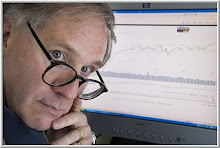Sunday, March 30, 2025
The Psychology of Playing a Big Market Opportunity
Sunday, March 23, 2025
Keys to Great Trading
The artistry of great trading is found in what we are doing when we're not staring at screens and firing away. Like the sniper, we succeed because of our focus during the 99% of the time that we're not firing. Creative vision is what makes a work of art. It is also what makes for artful trading. Skilled traders have studied and experienced so many markets that they can recognize when a meaningful pattern is playing out. What if we only traded when that creative insight came to us, when we saw--truly saw--how things were playing out? The cost of overtrading lies not just in the P/L lost, but in the damage we inflict upon our capacity for creative insight. Our job is not to make great trades; it's to have the wisdom and restraint to allow great trades to come to us.
Sunday, March 16, 2025
Answering Traders' Questions
The first question is: "Given that markets constantly change, how can traders develop the psychological flexibility needed to adapt their strategies without falling into emotional overreaction or hesitation?"
Brett's response: This is a great example of a situation where improvements in trading process can create improvements in our trading psychology. Basically, what active traders need is real time information that tells them that their market is changing. The professional traders I work with at hedge funds monitor real time price change, of course, but also real time market volume and volatility and real time correlations. Very often, shifts in volume/volatility and correlations precede shifts in trading direction. A simple example would be a stock that moves out of a range to the upside but then stalls on low volume. If this was a valid breakout, one might expect short-term participants to take advantage of the move, resulting in increased volume and volatility. One might also expect that, if the stock's upside breakout was valid, it would be accompanied by similar moves in other stocks in the same sector and perhaps by similar moves in the overall market. By monitoring this real time behavior, traders can become highly flexible in jumping aboard moves or fading them. Once the market changes are perceived and understood in a broader context, the trader can quickly adapt.
Recently, the market made an intraday high but many sectors (including small caps) lagged significantly. This was very helpful information in fading the strength. Practicing trading with small size while making these observations and adaptations provides the experience that leads to confidence. How the market moves is just as important as the moves it makes.
Tuesday, March 11, 2025
What Kind of Trader Are You?
There are basically two types of traders. The first generally trades very short-term and places many trades per day. This fast trader excels in pattern recognition and also excels in the ability to maintain high levels of focus and flexibility of perception within and across trading days. Often these traders are quite competitive and love finding and pursuing opportunities that set up on the screens or in the order books. For instance, the fast trader will notice volume expanding on a break out of a short-term range and may quickly jump aboard that move, with the idea of stopping out on a return to that range.
The second type of trader typically holds for longer periods of time: intraday or multi-day/week swings. The ideas being traded are typically less about short-term pattern recognition and more about themes that are emerging within and across markets. For example, the bigger picture trader will see selling in stocks at the same time that there is buying in bonds, driving yields lower. The trader identifies this as the start of a risk-off theme in the market and might buy defensive stocks and sell growth shares. The intellectual challenge of finding and exploiting themes is a major motivator for these traders.
When the fast trader attempts to trade longer time frames, the near-term pattern recognition (a strength) can actually pose distractions. When the bigger picture trader attempts to trade short time frames, the intellectual curiosity/creativity of finding themes (a strength) can actually interfere with timing. In other words, problems with our trading may not occur due to our weaknesses, but because of a misapplication of our strengths.
What we do well and what speaks to us is our surest path to success.
Further Reading:
Mastering the Positive Psychology of Trading
.
Tuesday, March 04, 2025
Identifying Themes in the Stock Market
Notice how there is a pattern to all this: First we see reduced participation when the broad index makes marginal new highs and then we see *changed* participation as bear market activity commences. The relative action of the stock market sectors tells us whether the themes dominating investors are related to growth or defensiveness; whether we're seeing broader participation or reduced participation. Charts can be very helpful in identifying points to enter and exit when you get to the point of executing your trades. But it's themes that provide the most reliable information re: *what* and *how* you should be trading.
Further Reading:
Understanding Market Themes From Sector Breadth
.









